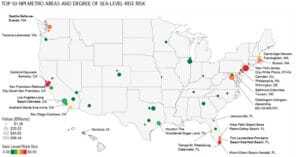“Gateway markets”—the largest global cities, including New York City and the San Francisco Bay area in the United States—represent a large share of total investment and carry a heavy weight in institutional real estate portfolios. They are characterized by concentrations of service industries such as finance, law, consulting, media, and design. They also are key transport nodes, possessing hub airports with global links. Almost all are coastal cities, with their business districts close to sea level. This is no accident. The economic primacy of gateway markets, in most cases, was forged through historical flows of ocean-borne trade, information, and migration. Indeed, to this day the presence of a major seaport helps drive the dominance of many gateway markets.
For all their luster and investor appeal, however, coastal cities and their real estate markets face considerable risks from rising sea levels and other impacts of climate change, such as more extreme seasonal king tides and storms that occur with greater frequency and intensity. Given significant portfolio allocations to gateway markets, institutional real estate portfolios have considerable exposure to climate change. This raises the question as to whether investors have factored in the challenge of rising sea levels alongside the perceived positives of gateway markets.
How Much Risk?
Heitman, working with climate risk analytics firm Four Twenty Seven, sought to quantify the concentration of sea-rise risk within institutional real estate portfolios in the United States. Four Twenty Seven also evaluates other aspects of climate risk, such as hurricanes, extreme rainfall, heat stress, and drought, but we decided to focus our initial work on sea-level rise. Sea-level rise presents the risk of routine property damage, rising insurance costs, and greater exposure to damage from severe storms, as well as knock-on impacts to local economies and governments. Looking at the total value of properties in the top 50 metropolitan areas in the National Council of Real Estate Investment Fiduciaries (NCREIF) Property Index, or NPI, we grouped them according to their risk level within Four Twenty Seven’s database.
The results indicate that large swaths of real estate value lie in areas at high risk of being affected by sea-level rise. More than 24 percent of the NPI value is in metro areas whose central cities are among the 10 percent of cities most exposed to sea-level rise. This amounts to more than $130 billion of real estate. And a whopping 67 percent of the NPI’s value, or $360 billion, is in metro areas whose primary cities are among the 20 percent most exposed in the United States.
Nine metro areas in the NPI’s top 50 are also among the 10 percent most-exposed cities in Four Twenty Seven’s database. Among those nine, two are gateway markets: In the San Francisco Bay area, the San Francisco, Oakland, and San Rafael metro areas are all in the top 10 percent in terms of risk; so is the New York City area, which has already seen significant flooding related to Hurricane Sandy in 2012. Not surprisingly, Florida figures prominently on the roster, with both Miami and Fort Lauderdale making the list. Rounding out these markets are Honolulu; Wilmington, Delaware; and inland but low-lying Camden, New Jersey.
This preliminary analysis does not drill down to the property level to assess individual assets’ exposure to rising sea levels. Such a granular approach would consider the elevation of each property above sea level and its location with respect to bodies of water at risk of flooding. It also does not take into account whether buildings are incorporating resilience strategies and features into their design and operations—for example, by elevating ground levels, entrances, and key mechanical elements. That said, within these metro areas, a large share of the commercial real estate asset base is located close to bodies of water, particularly in the case of central business district (CBD) assets, and is therefore likely at risk. Moreover, sea-level-rise risk is not just an “event” risk specific to a given property. Rising water levels are likely to damage the regional economy. Other costs shared across the metro area include regional climate adaptation costs that may need to be recouped through higher taxes or which are reflected in lower municipal bond ratings and higher borrowing costs for local governments.
What Can Investors Do?
In the context of such significant exposure, how should investors incorporate the risk of climate change into their investment strategies? Many investors assume that their risks are covered through insurance. But insurance policies typically require annual renewal, and premiums can skyrocket from year to year if risks come into focus. Moreover, insurance protects against actual losses, not the potential devaluation of a property due to shifts in the perception of risks.
Another lever that investors are using to manage risk is to focus on the property itself. Some new developments incorporate physical characteristics that attempt to achieve resilience against climate change by, for example, constructing storm surge barriers to protect against flooding or incorporating backup power to protect against major storms. However, building a resilient property is just one part of the equation; another part is having resilient infrastructure at the city level. A property could be prepared for a storm, but that goes only so far if the city’s streets are underwater.
A more holistic approach would address climate change at the portfolio level, looking at aggregate exposure to various climate risks. This is not simply a matter of diversifying property-specific event risk. Climate change will have consequences for asset performance beyond physical damage, encompassing regionwide effects such as the possibility of higher insurance premiums, higher taxes, lower economic activity, and lower investor demand. A redlining approach, in which the riskiest areas are simply avoided, may be too blunt a tool, but it could be appropriate for certain submarkets where asset-specific risk is compounded by these macro factors.
Heitman and ULI, with analytical support from Four Twenty Seven and contributors from the insurance and engineering sectors, are embarking on a joint project addressing climate risk in real estate investment. The collaboration seeks to understand how climate risks are being factored into real estate investment strategies, and how such decision frameworks might be improved upon to best manage climate-related risks. We will produce additional articles and papers as the project progresses.
MARY LUDGIN is head of global research at Heitman. She is a ULI Global Governing Trustee and sits on its Global Board of Directors.
Methodology
Our analysis categorized the top 50 metro areas within the National Council of Real Estate Investment Fiduciaries Index (the NPI) according to which decile they sit in relative to the cities tracked in Four Twenty Seven’s database of climate risk. The NPI tracks a large share of private institutional investments but excludes private noninstitutional and listed real estate investments. The top 50 metro areas in the NPI represent 86 percent of its overall value and constitute the main focus of institutional investment. Four Twenty Seven’s database includes every U.S. city with 50,000 inhabitants or more. Because Four Twenty Seven’s database scores risk at the city level, but the aggregate NPI figures are reported at the level of metro areas (metropolitan statistical areas or metropolitan divisions, where they exist), we assigned the risk decile of the relevant central city to each NCREIF metro area. For example, for the New York metropolitan area, we used the score for New York City. For metro areas without an identifiable central city, we used the risk quantile for the most relevant county in the metro area from Four Twenty Seven’s county-level database.





